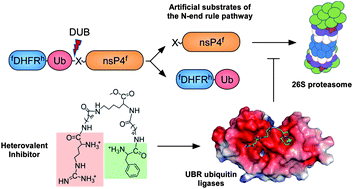Characterization of mammalian N-degrons and development of heterovalent inhibitors of the N-end rule pathway†
Abstract
The N-end rule pathway relates the in vivo half-life of a

* Corresponding authors
a
Department of Applied Chemistry, School of Applied Sciences, Kyung Hee University, Yongin 446-701, Korea
E-mail:
mjlee@khu.ac.kr
b
Division of Lipid Science and Technology, CSIR-Indian Institute of Chemical Technology, Hyderabad, Andhra Pradesh 500007, India
E-mail:
rkbanerjee@yahoo.com
c Department of Pharmaceutical Sciences, School of Pharmacy, University of Pittsburgh, Pittsburgh, PA 15261, USA
The N-end rule pathway relates the in vivo half-life of a

 Please wait while we load your content...
Something went wrong. Try again?
Please wait while we load your content...
Something went wrong. Try again?
Y. Jiang, S. K. Pore, J. H. Lee, S. Sriram, B. K. Mai, D. H. Han, P. Agarwalla, A. Zakrzewska, Y. Kim, R. Banerjee, S. Lee and M. J. Lee, Chem. Sci., 2013, 4, 3339 DOI: 10.1039/C3SC51059J
To request permission to reproduce material from this article, please go to the Copyright Clearance Center request page.
If you are an author contributing to an RSC publication, you do not need to request permission provided correct acknowledgement is given.
If you are the author of this article, you do not need to request permission to reproduce figures and diagrams provided correct acknowledgement is given. If you want to reproduce the whole article in a third-party publication (excluding your thesis/dissertation for which permission is not required) please go to the Copyright Clearance Center request page.
Read more about how to correctly acknowledge RSC content.
 Fetching data from CrossRef.
Fetching data from CrossRef.
This may take some time to load.
Loading related content
